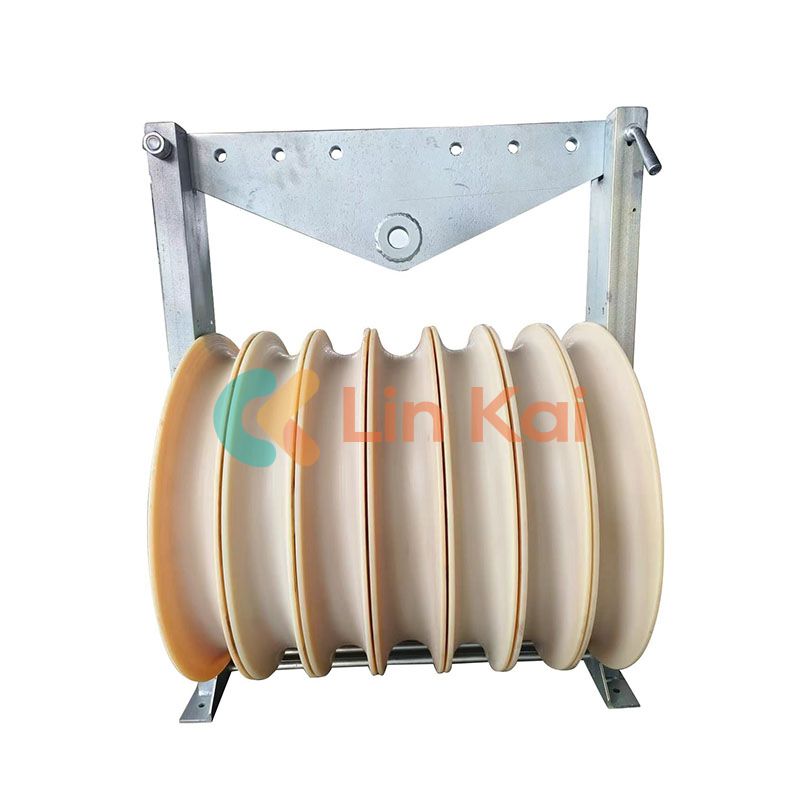What Are Conductor Pulley Stringing Blocks and Why Are They Essential for Power Line Construction?
2025-01-08
When it comes to the construction and maintenance of high-voltage power lines, several tools and equipment are involved to ensure that the job is completed efficiently and safely. One such tool that plays a vital role in this process is the conductor pulley stringing block. These simple yet effective devices help facilitate the installation of electrical conductors on transmission towers, making them a crucial component in the power industry. But what exactly are conductor pulley stringing blocks, and why are they so important for power line construction?
What Are Conductor Pulley Stringing Blocks?
A conductor pulley stringing block is a specialized piece of equipment used to guide electrical conductors (wires) during the process of installation on power lines. Typically made of durable materials such as steel or aluminum, the block is designed to withstand the significant tension and load involved in stringing conductors over long distances and rugged terrains.
These pulley blocks are mounted on transmission towers or poles during the construction process. They serve as guides for the cables being pulled across, ensuring that the conductors remain in proper alignment and are not damaged. The stringing blocks feature a large pulley wheel that allows the cable to pass smoothly over the structure, reducing friction and wear.
How Do Conductor Pulley Stringing Blocks Work?
The function of a conductor pulley stringing block is relatively straightforward but highly effective. During the installation of a power line, a stringing crew pulls the electrical conductors (usually steel-reinforced aluminum cables) across the transmission towers. The stringing block is installed at specific intervals along the route to support and guide the conductor as it is pulled into place.
Here's how the process typically works:
1. Preparation: The installation begins with the setup of the transmission towers, which are spaced at regular intervals along the route of the power line. The stringing block is then mounted to the tower at a height that ensures it is properly aligned with the conductor path.
2. Stringing the Conductor: The conductor wire is attached to a pulling line or rope, which is threaded through the pulley wheel of the stringing block. The pulling line is then connected to a winch or other pulling device that will draw the conductor along the path.
3. Guiding the Conductor: As the pulling device is activated, the conductor is drawn across the stringing blocks. The pulleys within the blocks allow the wire to pass smoothly over the tower without unnecessary friction, which could cause damage to both the conductor and the equipment.
4. Final Positioning: Once the conductor reaches the next transmission tower or pole, the process is repeated with the next stringing block until the entire power line has been installed. The stringing blocks guide the wire over each tower, ensuring proper alignment and safety during the installation process.
Why Are Conductor Pulley Stringing Blocks Important?
The role of conductor pulley stringing blocks in power line construction is invaluable for several key reasons:
1. Preventing Damage to Conductors: One of the most critical factors in power line construction is ensuring that the electrical conductors remain undamaged during installation. Without proper guiding equipment, the tension and friction caused by pulling the wires over long distances could lead to conductor breakage or fraying. The pulley blocks minimize this risk by providing a smooth surface for the cables to travel along.
2. Facilitating Efficient Installation: Installing power lines can be a complex and time-consuming process, especially when dealing with challenging terrains. The use of stringing blocks allows workers to efficiently pull conductors into place, significantly speeding up the process and reducing the manpower required for the task.
3. Safety: Safety is always a top priority when working with high-voltage power lines. Conductor pulley stringing blocks help ensure that the installation process proceeds without accidents, as they reduce the likelihood of wire entanglement, tension-related failures, or worker injuries. The blocks provide a controlled path for the conductors, making the entire process safer for everyone involved.
4. Handling Different Types of Terrain: Power lines often need to be strung across difficult terrains, such as mountainous areas, forests, or remote locations. Conductor pulley stringing blocks are designed to handle a wide range of environments. Whether the blocks are mounted on tall transmission towers or positioned on temporary structures, they can be adapted to suit the specific requirements of the terrain.
5. Longevity and Durability: Since power line construction projects typically span miles and can involve harsh weather conditions, conductor pulley stringing blocks must be durable and long-lasting. Made from corrosion-resistant materials, these blocks are built to withstand the rigors of outdoor work and the stress of heavy-duty applications, ensuring that they perform reliably over time.
Types of Conductor Pulley Stringing Blocks
There are several types of conductor pulley stringing blocks designed to meet different needs in power line construction. These include:
1. Fixed Pulley Blocks: These are the most common type of stringing blocks and are mounted on a stationary structure. They are ideal for guiding conductors in straight lines or along relatively level terrains.
2. Tension Pulley Blocks: These specialized blocks are designed to handle high-tension situations. They are often used when dealing with steep inclines or challenging terrains where there is a need to reduce the amount of force exerted on the conductor during installation.
3. Angle Pulley Blocks: These blocks are used to guide conductors at angles. They are particularly useful when the conductor needs to be pulled around bends or around obstacles such as trees or other structures.
4. Suspended Pulley Blocks: These are designed for use when space limitations prevent the use of traditional fixed pulley blocks. Suspended blocks can be hung from temporary support structures, allowing for more flexible installation options.
Conclusion: The Essential Role of Conductor Pulley Stringing Blocks
In the world of power line construction, every tool and piece of equipment plays a vital role in ensuring that the project is completed efficiently, safely, and without unnecessary damage. Conductor pulley stringing blocks, though often overlooked, are crucial in guiding and managing the installation of power lines. By reducing friction, ensuring smooth conductor travel, and helping to control the installation process, these blocks contribute to the reliability and safety of our electrical infrastructure.
As power needs continue to grow and infrastructure projects expand, the importance of efficient and effective tools like conductor pulley stringing blocks will only increase. Whether they are used on vast stretches of land or in challenging environments, these simple devices remain an indispensable part of the power industry, ensuring that electricity reaches the places where it is needed most.



